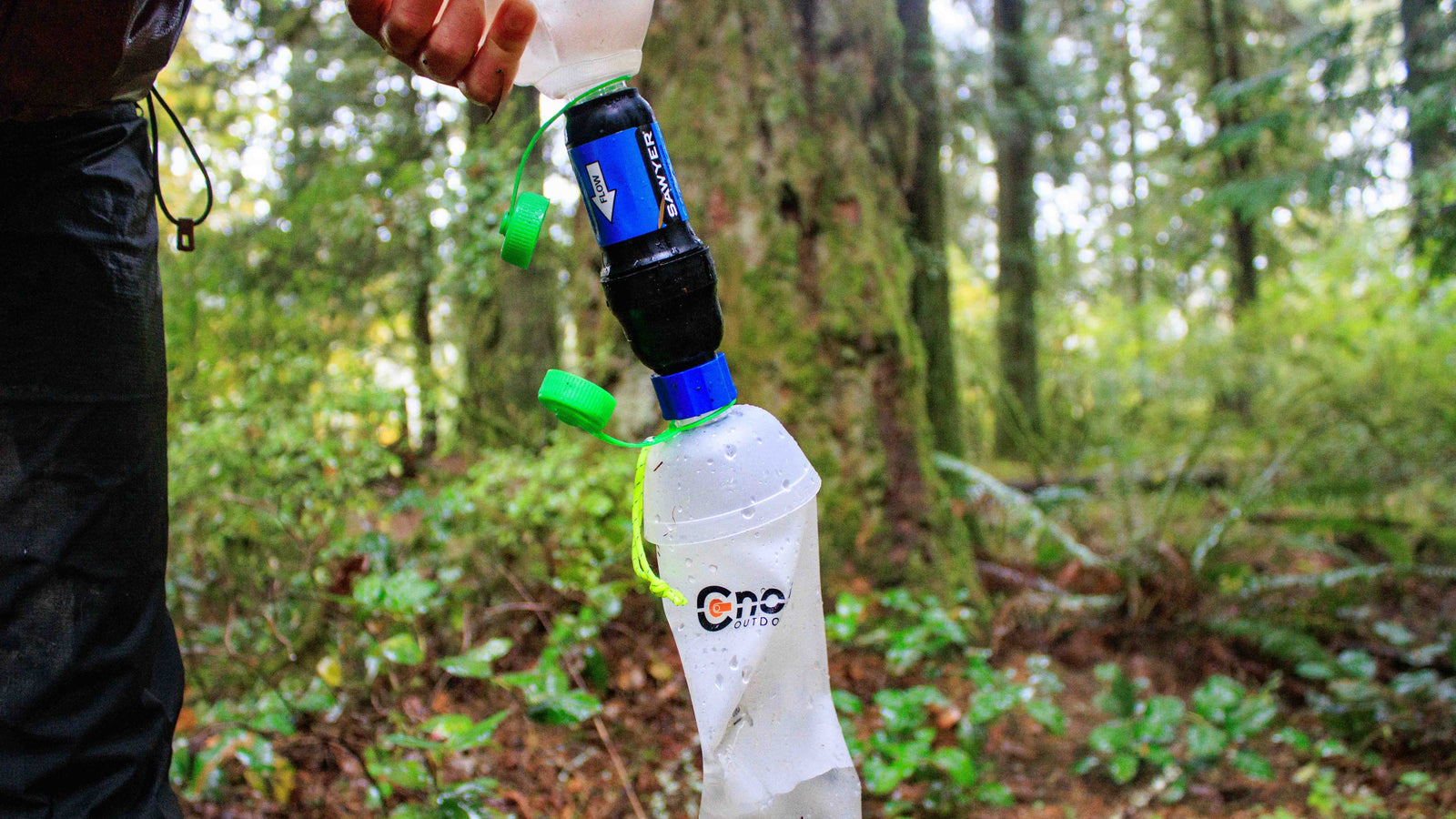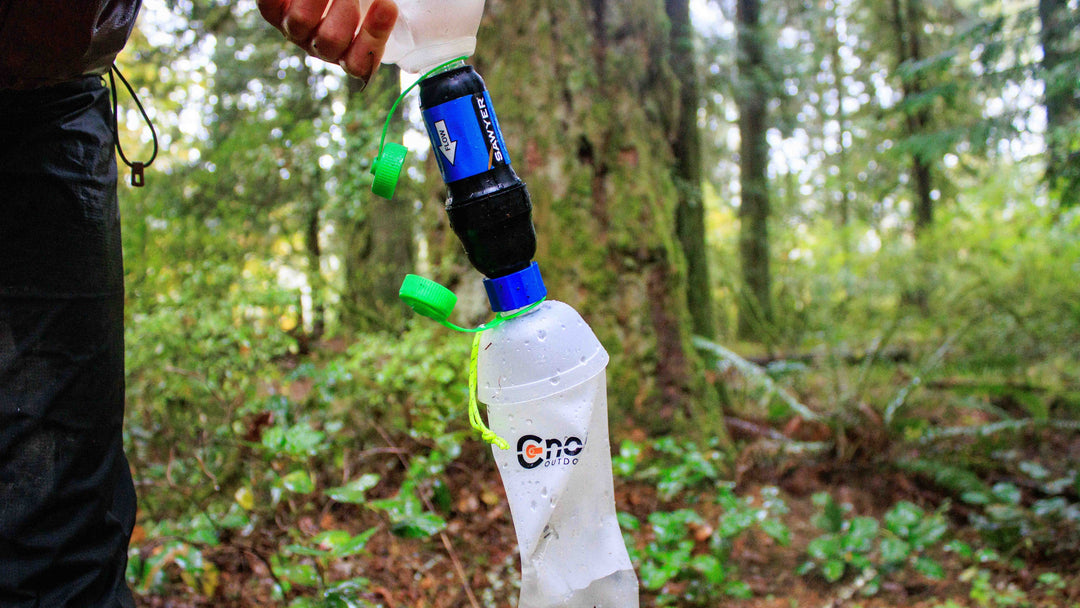Nanoplastics, microplastics, leaching in backpacking gear: Cnoc's place in it all

Lately we have been getting an increasing number of inquiries questioning the connection of our products with nanoplatics or microplastics, asking if TPU is leaching like PET, etc. Here are some examples:
"With recent proof that plastic bottles have us ingesting plastic materials, I was wondering if tpu used on your products is the same."
"I wanted to ask about chemical/plastic leakage from Cnoc bottles and bladders when exposed to extreme heat and UV exposure."
These are excellent questions and probably derived from the exposure that an excellent research study on the measuring of nanoplastics in bottled water got when it was published in January 2024.
The big problem with those questions is that they are mixing several terms, studies, impacts and control factors into a single question, when in reality, those are different issues. Mass media has, once again, done a disservice to the science behind those terms, creating information aimed for click-baiting more than educating.
In order to clear up some of those topics, I'd like to take them apart, look into each of them separately and maybe offer a real and cohesive answer to the questions we've been getting. I'd like to explain what each term (Nanoplastics, microplastics and leeching/food grade) is, how it relates to the products we make and what we know about our impact here.
Nanoplastics
Nanoplastics is a very, very new term, and an even newer field of study in chemistry, environmental studies and (maybe) product design. Nanoplastics are essentially, polymer based particle (aka plastic) that is smaller than one micron (1 μm) and are considered a potential danger as they are small enough to enter into cells.
The reason those are potentially dangerous particles is mainly due to the fact that we have not yet had enough studies about those particles, especially with long term effects. Most of the studies provided anecdotal findings that indicate that nanoplastics can enter cells and have been found in various examined pathologies. Currently, we don't know much about this due to the fact that it is so hard to find nanoplastics. Here is the research that has been causing all this rush of conversation about plastics, specifically:
"Rapid single-particle chemical imaging of nanoplastics by SRS microscopy"
This study from Columbia University provides proof of a new technique to detect nanoplastics - nothing about finding, just the method. As a test to the new detection process, the researchers examined water from bottled water to set a baseline. The water in the bottle showed high levels of nanoplastics, though the study makes no claims about the connection between the PET bottle the water is stored in and the nanoplastics. Sadly though, this is what the media got from it: PET bottles make nanoplastics, which is a false claim.
What we do know is that we don't know anything (or enough) about nanoplastics: not why they are present, what makes some plastics degrade to a non level vs a micro level, what is the impact or anything related. This is a new field and most definitely an important one.
Realistically, nanoplastics research will tell us many things, but probably very little that is related to us (Cnoc) - mainly to how synthetic polymers exist in nature and their part in it. This is way more philosophical than what we do here at Cnoc.
For more about nanoplastics, dig around here.
Microplastics
Microplastics are similar to nanoplastics: they are a a synthetic polymer particle, but one that measured between 1 to 5 micron. These have been detectable for several years now, leading to important research about them - though mainly still as an observation rather than the impact conclusion. The knee jerk reaction (and probably the right one) is that those microplastics are not good for us or anything else around us.
Most of the microplastics research looks at the presence of those particles in various environment (marine, air, etc) and tries and asses the impact of different polymers on their prevalence and dangers. All those studies focus on the presence of microplastics due to unprocessed trash and its presence in the environment. This usually doesn't look at biodegradability, recycling, downcycling or anything else. In simple words: if you throw a piece of trash on the ground or in the water, what is the impact of that trash if it is made of X plastic?
The leading research that we rely on is:
"Ranking of potential hazards from microplastics polymers in the marine environment"
This study looked at a variety of polymers and ranked based on 5 criteria:
- Prevalence: how much trash of that polymer ends up in the water
- Polymer density: how heavy the polymer?
- Degradation: how quickly/how much does the polymer degrades in nature
- Particle size: how small the particles are when degraded
- Chemical composition and the potential hazard of that
The the end, each polymer gets a calculated score of danger based on the above criteria. I will not go through all the results here, but I do recommend reading this article, probably over several days, as it contains so much information.
To our business: Cnoc uses TPU in our products and it is the main polymer we are looking at. Interestingly, TPU is not doing very well in this study as it breaks down relatively quickly into small particles and it is a heavy polymer. The only issue with TPU in this study is that they couldn't find much of it, in fact they found so little, that it ended up getting similar ratings as PUR (Polyurethane) though they are very different under the right conditions.
One of the main factors for us and the longer term impact of TPU is that it is so reusable, so very rarely, and substantially less than other polymers, does it make it to the trash pile. Another benefit of TPU is that it can be biodegradable in an active (hot) compost in 3-7 years.
Leaching/Reusability/Food Grade
This category is probably the core of the conversation, much more than microplastics, and what most of the people contacting us really want to know. This is mainly coming in the context of shown impact of PET in high temperatures and chemical leaching over time.
This is actually a very known factor and has been part of our life for a while. In fact, this is a big part that it testing for chemical leaching of materials over time is art of the FDA and EU "Food Grade" approval material. This testing is something that most companies should (hopefully) conduct before starting to sell a food contact product, though the FDA can be slightly murky about it if the product is sold without the food and water in it.
This questions that we are being presented are mainly due to the fact that many thru-hikers and ultralight hikers opt to use PET bottles repeatedly over time as a reusable bottle. Specifically, this relates to SmartWater bottles and how our Vesicas fare compared to those.
The short answer is that PET has shown to leach Phthalate into water and other substrates at high temperatures. PET has not been deemed a reusable material and is only approved in the EU as a disposable food-contact container with clear storage instructions, mainly: out of the sun.
Phthalates are dangerous and have been found in a host of places, from contaminated water sources to packages beverages to pig feeds. It was found the PET at high temperature is linked to the presence of phthalates in a substrate, specifically in water.
Now to our answer: what about Cnoc's products? Again, the short answer is that we don't have any known leaching from the TPU used as tested by Applied Technical Services in 2020 (0.3mm TPU) and again in 2021 (0.4mm TPU), both tests found that our TPU is above and beyond what the EU expects for food grade, specifically: EU requires less than 10 gm/dm2, ours is at 0.6, pretty low.
We are planning to continue testing our materials and our next test is due to be even more rigorous to simulate years of use, but from what we already know, TPU is pretty safe to use in a variety of way. It is so safe, in fact, that it is the same material used for baby bottle nipples: BPA/C/F free TPU.







Very interesting! Thank you, Gilad, for going through all this effort to summarize this research to the best of your abilities. I think a lot of us, front country and backcountry folks alike, have regretfully just accepted the micro/nanoplastic problem. That doesn’t mean we can’t work to clean things up! Yeah the damage is done, but here’s hoping we can start keeping the progressive damage at a minimum. Thanks again.
Leave a comment